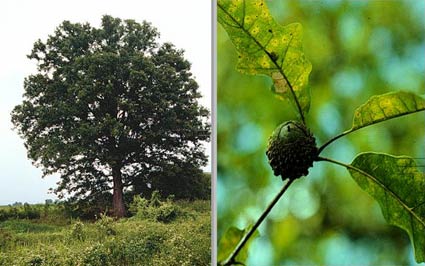The fall season is approaching, and cooler weather is hopefully just right around the corner. With changing temperatures, all our trees are going to be going through a change as well. As we enter the dormant season, we will be gifted with…
Lecanium Scale (Part One)
If “Lecanium” is a new word for you, consider yourself lucky, or at worst, blissfully ignorant. If you have experienced species of this genus in your landscape you may know how devastating, unsightly, and generally… uncomfortable this insect can be. If you have ever stood under a tree covered in a scale population which is actively feeding and digesting you will know why the word “uncomfortable” came to mind. In this installment I will briefly describe Lecanium scale and its life cycle. In the next installment, I will share an unusual finding from last season, and stand out on a limb to make a forecast for this season.
Putting the Year to Sleep
Today the light begins to increase again; days begin to lengthen. For the last 6 months or so each day has lost a minute or two of daylight, growing shorter as this part of the world approached the darkest day of the year. Earlier this week I was reading the musings of Henry David Thoreau once again, and came across a passage about the wonders of a milkweed seed, how each seed is carefully packed within its “light chest” attached to silk streamers, to be released when the time is right. Thoreau ends the thought with a quiet reflection on the faith of a milkweed plant which “matures its seeds” despite the prophecies of some men that the world would end.
Test Before Treatment: Soil & Tissue Testing
I find it interesting that test procedures recommended in the medical field for human health have become part of the expected methodology, but not so much in arboriculture, for tree health. As arborists, we are trained that a soil test should be done prior to recommending fertilization, for example, but I don’t know of many outfits that make soil sampling a part of their modus operandi.
The Importance of Green Leaves
I have been noticing what I consider to be an unacceptable amount of chlorosis in urban trees around Columbus. In general, chlorosis is the yellowing of plant foliage caused by a lack of chlorophyll. This is a problem because plants depend on chlorophyll to absorb energy from sunlight and to survive. Several…
✅Overcup Oak
General Info
- Latin Name - Quercus lyrata
- Native Range - New Jersey to Florida, west to Missouri and Texas
- Growth Rate - Medium, Fast in youth
- Mature Height - 40–60’
- Mature Spread - 40–60’
Arborist Thoughts
- An excellent oak for use in challenging sites. Overcup oak is a bottomlands species in its native habitat and adapts well to poor quality soils, poorly drained sites and restricted root zones.
- Overcup oak transplants well and is faster growing than most other oaks in the white oak group.
- Great specimen tree or a street tree for areas where overhead utilities are not an issue.
✅Chinkapin Oak
General Info
- Latin Name - Quercus muehlenbergii
- Native Range - Maine to Virginia, west to Minnesota, Nebraska and parts of Texas
- Growth Rate - Medium
- Mature Height - 50–60’
- Mature Spread - 50–60’
Arborist Thoughts
Strong drought tolerant Ohio native with clean lustrous dark green foliage and nice pyramidal habit.
Important tree for wildlife producing sweet and nutritious acorns. Good tree for wildlife habitat also.
More adaptable to high pH soils and urban landscapes than oaks in the Red oak group (pin oak, Northern Red oak, Shingle oak, etc).
Great long-lived specimen for an area that can accommodate a larger tree.
Oak Wilt in Franklin County
Several weeks ago a client called the office about some Red Oaks that were dying, one by one. I arrived at his home in north Columbus and he quickly filled me in on the details: Two years ago one tree died, last year one other tree died (neighbor’s tree nearby) and this year two more trees had died.



